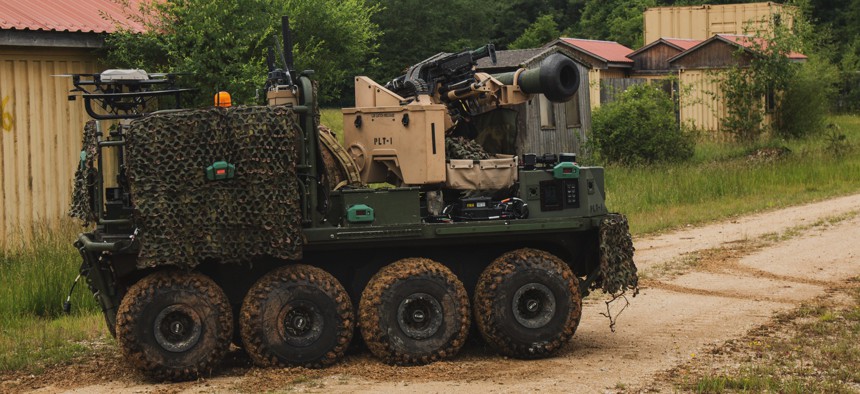
The Project Origin robotic combat vehicle is shown during training for U.S. Soldiers assigned to 1st Battalion, 4th Infantry Regiment at the Hohenfels Training Area, Germany, June 6, 2022. U.S. Army / Spc. Christian Carrillo
NATO Readies Strategy To Steer Use Of Autonomy
The document, expected later this year, will include moral and ethical guidelines on how to best use autonomous technologies.
NATO is planning to release guidance on how to use autonomous technologies by the end of the year, according to an official.
The document is in the works and headed into negotiations with allies, David van Weel, NATO’s Assistant Secretary General for Emerging Security Challenges, told reporters on Friday.
“What we're trying to do, just like we did with the AI strategy, which is very not-NATO-like, is to make as much unclassified as we can. Because we feel it's also about creating trust with the populations and if you keep this all secret then there's not much trust to be gained,” van Weel said at the Special Competitive Studies Project’s Global Emerging Technologies Summit.
The alliance released several strategies around emerging or disruptive technology areas, including artificial intelligence and space. Van Weel said the autonomy strategy would follow similar paces as the AI strategy, accounting for moral and ethical uses. NATO is also exploring other technologies, including quantum and biotechnologies, with initial reports expected by early 2023. Other work in data exploitation and operationalizing responsible AI in defense is also underway.
“So we'll be looking at responsible use of autonomy. We'll be looking at common standards that we expect all the allies to adhere to,” he said. “I feel that the moral and ethical side will be important” to address potential dilemmas for autonomy and other areas like human enhancement or bio-attack.
NATO has been expanding its foothold in tech investments and policy, launching two initiatives earlier this year to encourage adoption of commercial technology for military use: the Defence Innovation Accelerator of the North Atlantic, or DIANA, and a venture capital fund for startup companies. No startups have been selected yet but the goal is to install a general partner and investment team by early next year with investments to follow.
“AI, data, the use of autonomous vehicles, quantum which will be upcoming, biotech, human enhancement, we see huge progress being made in all these fields,” in the commercial sector],” Van Weel said. “But we hardly see anything of that coming into the realm of defense in an efficient manner.”
To fix that, NATO is watching the Ukraine conflict for clues on tech priorities.
“We see Ukraine as an encouragement that we're doing the right thing, because a lot of the technology that's now seeping into Ukraine comes from the commercial sector,” van Weel said.
One example of that, he said, is how Ukrainian forces are using what he called "Uber for artillery" to pinpoint target locations and fire within seconds using AI.
"So it's developments like that, that are now, under pressure, coming to bear that we're trying to incorporate in our peacetime modes of working to unleash that potential that is already there to create new opportunities."




